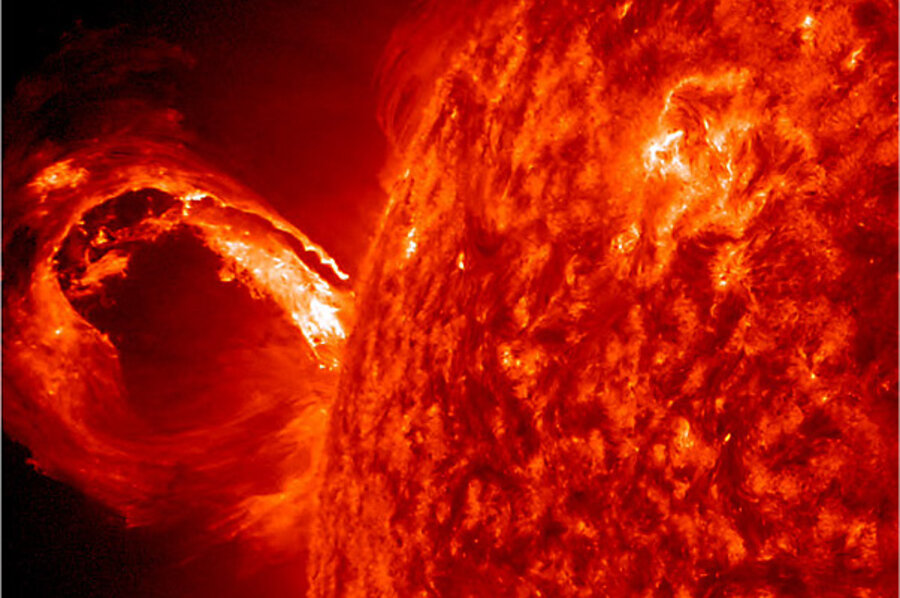Sun belches humongous plume of radioactive plasma: What you need to know
Loading...
Right now, Earth is in the path of not one but two coronal mass ejections (CMEs). One burst from the sun's surface early Tuesday morning, moving fast, and the other left not long after midnight early Wednesday morning, moving more slowly.
When the sun erupts a huge burst of matter and energy like this, the particles can fly anywhere between 200 and 1000 miles per second, says Art Poland, an astrophysicist with George Mason University. Tuesday morning's CME was moving at 570 miles per second, NASA reported, and Wednesday's was a more sedate 380 miles per second. The charged particles from the earlier CME may already be in our atmosphere, while Wednesday's particles could reach us by midnight Friday night (Eastern Time).
Solar flares, like coronal mass ejections, follow the sun's 11-year sunspot cycle, and right now, we're near the peak of solar activity. "At solar minimum we observe about one CME a week. Near solar maximum we observe an average of 2 to 3 CMEs per day," reports NASA's CME website. That's including CMEs shooting out in any direction, but these two are heading towards Earth, which means the situation in our skies could get interesting soon.
What's the difference between a solar flare and a CME?
Solar flares are to coronal mass ejections (CMEs) what lightning strikes are to hurricanes. They're related, sure, but much, much bigger. The most obvious differences have to do with scale. Solar flares happen on the surface of the sun, but CMEs can balloon out larger than the sun. Solar flares release charged particles toward Earth (sort of the sun's equivalent of a bolt of lightning), but CMEs can send massive clouds of plasma our way, carrying over a billion tons of particles traveling well over a million miles per hour.
They're both caused by the sun's magnetic field, explains Dr. Poland, the project scientist on SOHO, NASA's orbiting solar observatory. "The sun is really exciting in that its magnetic fields are dynamic – always changing," says Poland. "Sometimes they get into a configuration that causes a rapid release of energy. That released energy can be seen in two ways: One is that you get a flare. It gets really bright, and really hot – up to 20 million degrees or more, while the surface of the sun is ordinarily about 5,000 degrees. The other thing that happens is that these magnetic fields expand and fly off, out into space, causing what we call a coronal mass ejection."
He continues, "Take a soap bubble. You keep putting more and more air into that soap bubble. You put too much air in, and the soap bubble goes BANG! The same thing happens with a balloon. The pieces of the balloon or the soap bubble go flying out into space. Although in this case, actually, the whole structure goes flying out into space, not just pieces of it."
A better visual, he says, though one that's less scientifically accurate, is this: "If you take a balloon and blow it up, and blow it up, and blow it up, and then you let it go at the bottom, it goes flying out. That, in a way, is what's happening – not physically, but visually – this balloon or bubble is flying out into space.... And then the balloon, all still expanded, crashes into Earth's magnetic field."
And that's when things really get interesting.
Earth's magnetic field usually protects the planet like an invisible cocoon, shielding the surface and near-Earth satellites from solar radiation, but the energy slamming in from a CME can shove the magnetic field out of its usual configuration, explains Loraine Lundquist, a physics professor at Cal State Northridge. On the side far from the sun, the magnetic field is pulled out farther than usual, while the side facing the sun is flattened down toward Earth's surface. If the magnetic field is pushed far enough, communications satellites can find themselves outside of its protective envelope, vulnerable to the incoming solar storm.
"The magnetosphere can go inside geosynchronous orbit distance, for example, leaving those satellites out – basically unprotected – outside the magnetosphere," says Dr. Lundquist. Like Iron Man without his suit, these satellites are then suddenly acutely vulnerable to the solar storm. The charged particles can't physically move the satellites, but they can "wreak havoc with the electronics," she says.
Solar storms can also affect the power grid, resulting in surges, shorts, and even power outages. CMEs also disrupt the ionosphere, notes Poland, which can affect shortwave radio, AM radio, and GPS signals. The GPS in your car or on your phone can usually pinpoint your location to within a few feet, but during a solar storm, it can be off by a few dozen feet or more.
But "the most obvious" effect of solar storm activity is visual, says Poland: the Northern Lights. When those billions of charged particles hit Earth's atmosphere, the collisions glow in countless beautiful ways. Earth's magnetic poles channel the collisions toward the poles, causing the Northern and Southern Lights, also called the aurora borealis and aurora australis. "The next night or two will be a good time to look for Northern Lights," says Poland.






